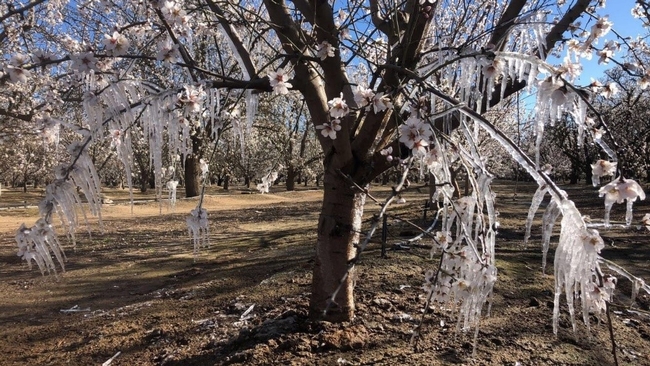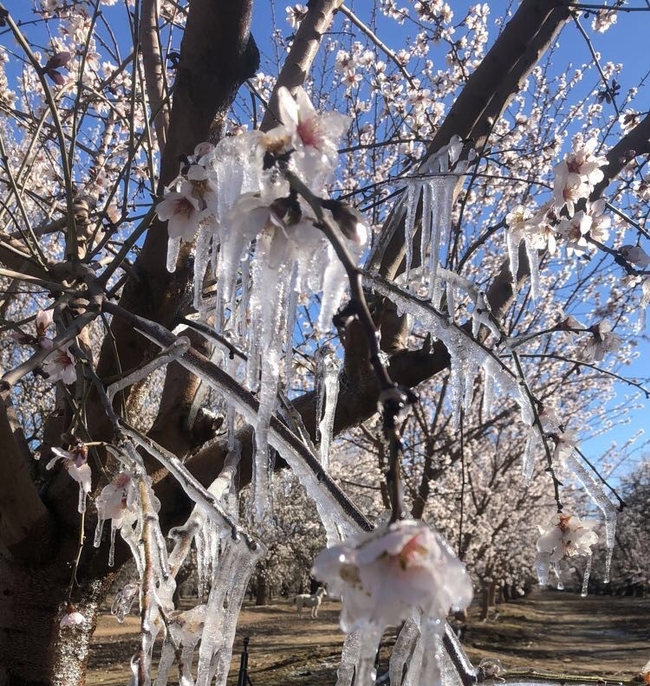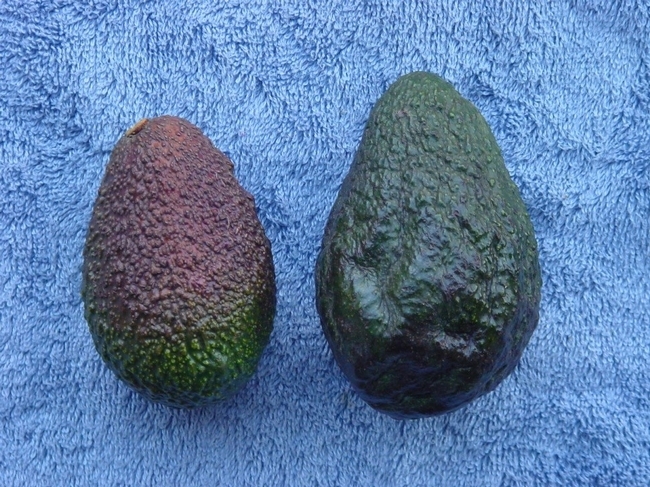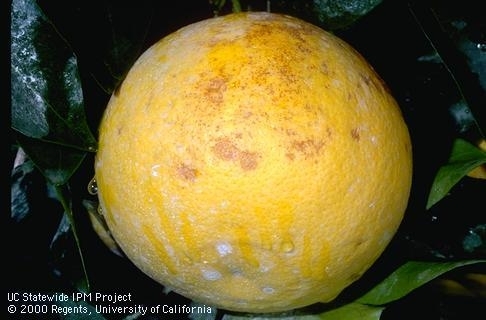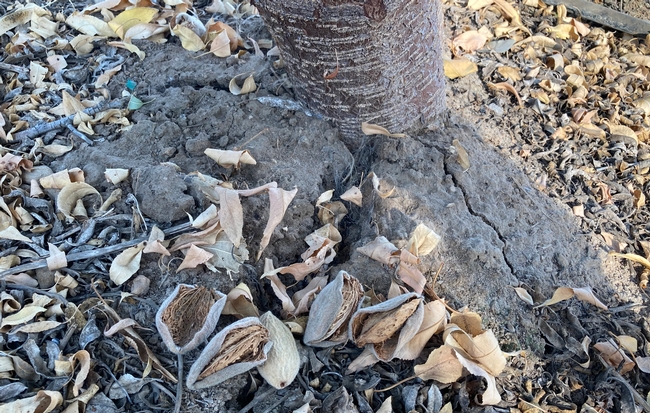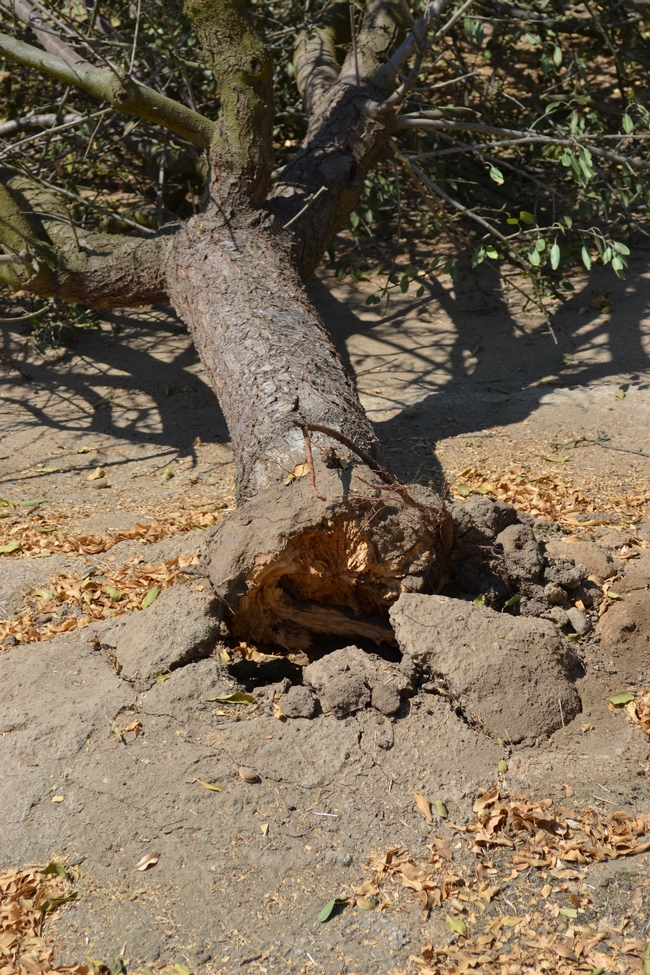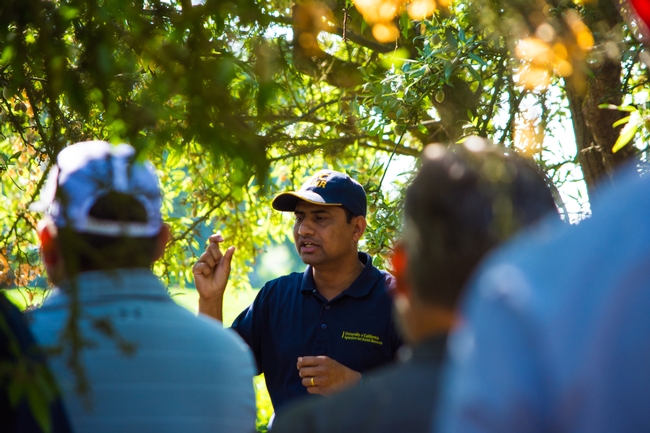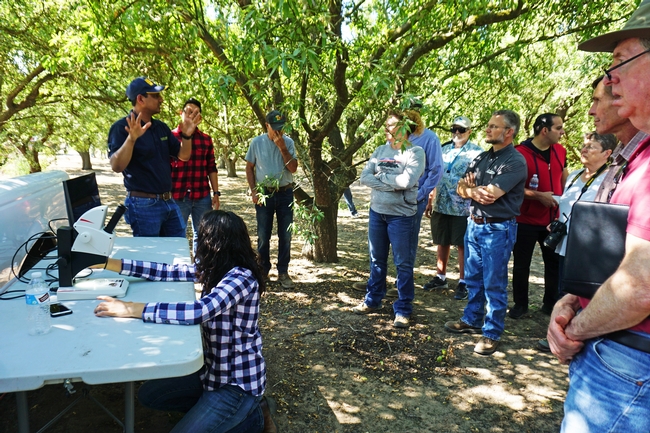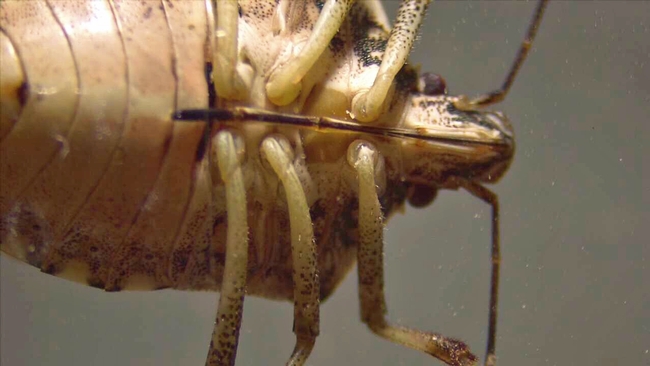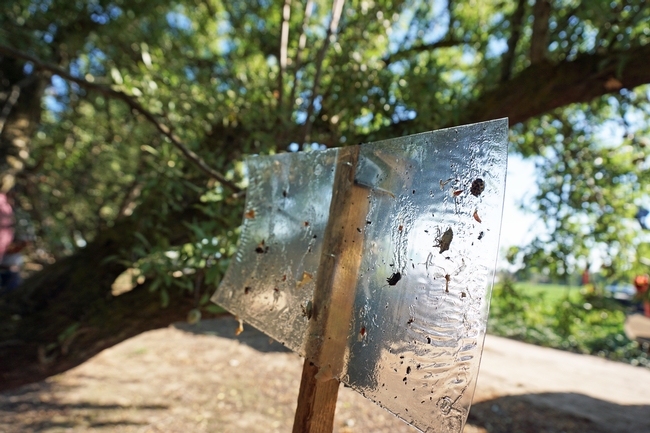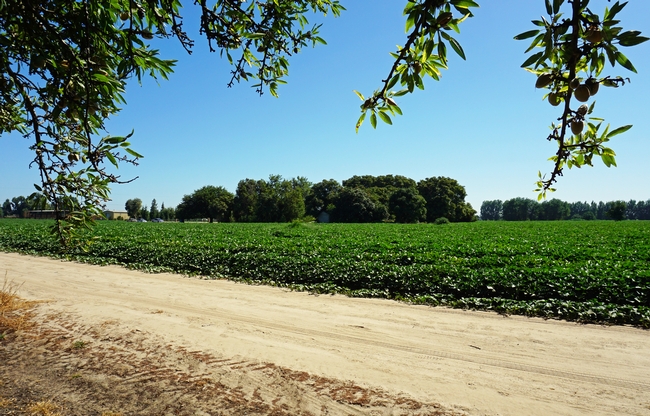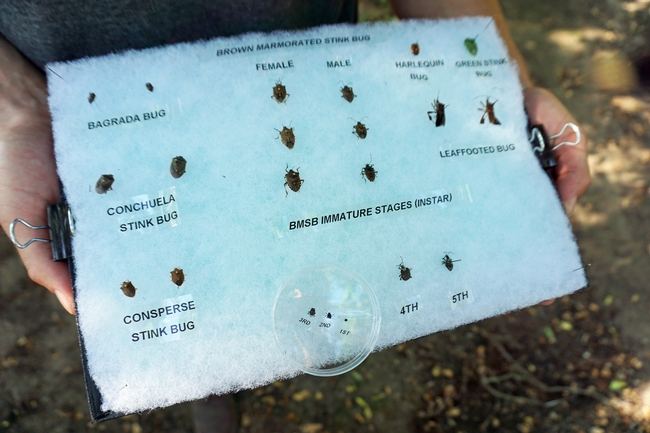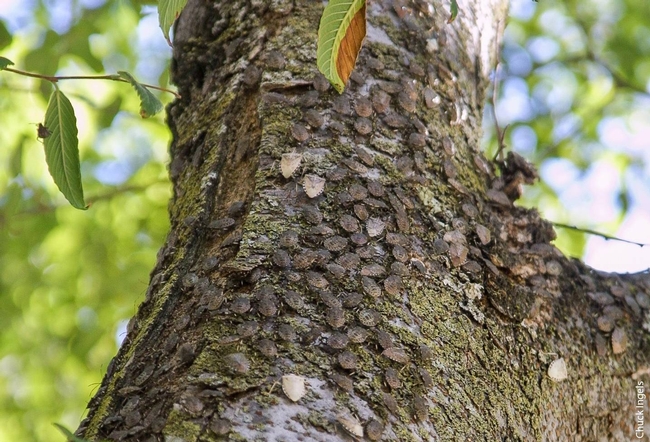Posts Tagged: Almonds
Climate change may reduce frost damage to orchard crops
CalAgroClimate web tools help farmers prepare for frost events
A cold snap damaged almond blossoms across the Central Valley, resulting in more than $44 million in crop insurance claimsin late February 2018. A multi-day frost event wiped out roughly 75% of California's citrus crop and severely damaged avocados in January 2007. Frost can damage crops, impact growers' bottom lines and drive up food prices for consumers. With advance notice, farmers may be able to use heaters, wind machines, irrigation and other tactics to lessen some of the impacts of cold weather, such as damaging near-ripe citrus fruit or killing the bloom in almonds.
CalAgroClimate is a new farmer-focused website that can help growers anticipate weather-related risks and make plans for taking defensive action. Growers and crop consultants can use CalAgroClimate's crop and location-specific tools and resources to help prepare for upcoming frost events. The website's tools can also support on-farm decisions for managing heat, crop development and pests.
Future holds less frost
The risk of frost damage to crops and the need to prepare for that risk is top-of-mind for many farmers today, but will it always be so? To examine what climate change might mean for future frost risk, researchers at UC Davis, UC ANR and the USDA California Climate Hub conducted a study examining the incidence of temperatures below multiple “frost thresholds” during the months of critical development phases for three frost-sensitive California crops: almonds, avocados and navel oranges.
The researchers found that even during the coldest winters and springs, the incidence of frost exposure declined under projected mid-21st century climate conditions by more than 50% for almonds and oranges, and by more than 75% for avocados. While farmers in 2050 will not find frost risk to completely be a worry of climates past, they will not have to contend with the same frost concerns that farmers face today.
Beyond the obvious benefits of reduced risk of crop damages, additional benefits of reduced frost exposure include lower water use and energy costs associated with mitigation actions. Irrigation is a primary means of protecting crops from frost temperatures, and with fewer hours below freezing that means fewer hours of running water and using pumps. The authors of the future frost exposure study showed that growers may collectively save tens of thousands of acre feet of water and enjoy millions of dollars in energy savings.
Few aspects of climate change are considered “positives,” and although the warming winters and springs that result in reduced frost temperatures could also come with increased pest pressure, reduced chill accumulation and other challenges, the reduction in frost exposure is a silver lining.
However, until this frost-free future arrives, growers still need to be prepared to protect their orchards from frost. To assess frost risk for the next seven days for your location, check out the new interactive Frost Advisory Tool at CalAgroClimate.org.
How to 'Bee My Valentine': Let's Help Out the UC Davis Biodiversity Museum Day
You can "Bee My Valentine" today--and throughout the month of February--by contributing to the UC Davis Biodiversity Museum Day. What is the UC...
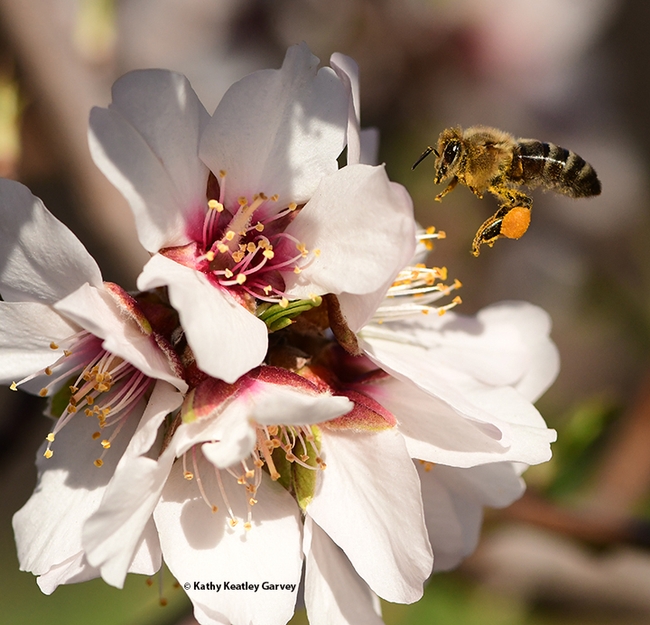
A honey bee, packing a load of orange pollen, heads for another almond blossom on Feb. 7, 2022 in Vacaville, Calif. Honey Bees are an integral part of the UC Davis Biodiversity Museum Day. (Photo by Kathy Keatley Garvey)
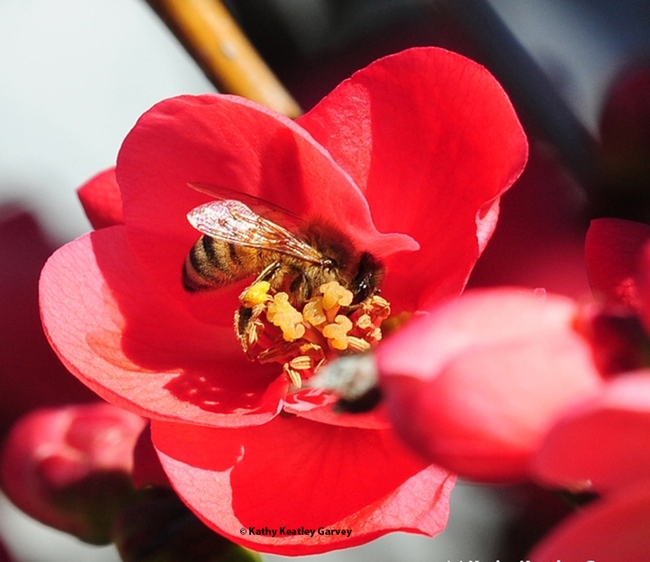
A honey bee foraging on a flowering quince. (Photo by Kathy Keatley Garvey)
A hike in navel orangeworm pressure expected later this century due to climate change
Outsized wildfires, rising sea levels and disappearing glaciers are dramatic signs of climate change, but not the only ones. New UC Agriculture and Natural Resources research provides forewarning of a change that will be economically and environmentally costly to California – a fifth generation of navel orangeworm, the most destructive pest of almonds, walnuts and pistachios.
Navel orangeworm (NOW) will be more problematic in the future because of warming temperatures, UC Cooperative Extension scientists report in Science of the Total Environment.
Like most insects,NOW's development rate, physiology, behavior and reproduction are highly dependent on the ambient temperature. When the weather warms in the spring, NOW moths emerge from the nuts left in the tree or on the ground during the winter. After mating, females then recycle those last year's nuts to lay eggs and complete one generation. Adults emerged from that first and subsequent generations then lay eggs on in-season hull-splitalmondnuts, where larvae feeding damages the crop. Typically the pests fly three to four times per year – with more flights in areas with warmer weather.
“Warmer temperatures can result in early activity of the pests in the spring and increased activity during the season,” said Tapan Pathak, the UC Cooperative Extension climate change specialist and the study's principle investigator.
The scientists looked at 10 climate models to determine what nut farmers can expect to face over the next 80 years and applied NOW developmental models to the changing climate. Daily maximum and minimum temperature data were obtained for 1950 to 2005, and future projections stretched to 2100.
“The fifth generation can happen in the next few decades,” said Jhalendra Rijal, UC integrated pest management advisor and co-author of the research. “The climate models suggest that spring will begin earlier. That causes insect activity to start earlier. With increased temperatures through the season, the number of days to complete a generation is less. At the end of 2050 or so, we'll see an extra generation.”
The study focused on 23 counties in the Central Valley, from Shasta County in the north to Kern County in the south, where 1.78 million bearing acres of nut crops are planted. About two-thirds of that acreage is planted to almonds, 20% in walnuts and 16% in pistachios. The tree nut crops were valued at more than $8 billion combined in 2018, according to the California Department of Food and Agriculture.
The completion of the NOW life cycle is faster in pistachio compared to almonds and walnuts, so the potential risk of crop damage and economic loss is higher in pistachio, according to the research report. There are only a few years historically in which the models detected the fifth generation of NOW in Kern County pistachios. The occurrence of the fifth generation in almonds and walnuts was historically nonexistent, but it starts appearing in three southern counties by 2040 and eleven counties by 2100.
“In order to alleviate some of the risks related to navel orangeworm damage to nut crops, it is important to implement integrated pest management practices,” Pathak said.
IPM preventative and control measures include sanitizing the orchard during the winter by removing all the nuts on the ground and in the trees, applying synthetic reproductive hormones to limit the pests' ability to find mates, encouraging natural enemies, judicious of least-toxic pesticides if necessary and harvesting the crop early to avoid a new generation of the pest.
“A better understanding of future navel orangeworm pressure on California's major nut crops can help facilitate and strategize integrated pest management practices in order to minimize production risks,” Pathak said.
The results of the research can also inform growers and pest control advisers about the potential increased threat from other pests as the climate changes.
Untreatable fungus giving almond producers pause
An airborne fungus from Europe, ganoderma adspersum, has been killing almond trees in the San Jaoquin Valley since it was discovered in the area five years ago, reported John Cox in the Bakersfield Californian.
The fungus rots wood from the inside out, usually weakening the trunk a ground level.
Three kinds of ganoderma fungus infections were identified recently in California almond orchards; University of California researchers say 94 percent of the cases were of the adspersum variety.
"We are seeing those trees collapsing at 11, 12, 15 years old,” said UC Cooperative Extension orchard systems advisor Mohammad Yaghmour. The infections have results in the removal of orchards at less than half their typical 20- to 25-year life span.
Spraying for the fungal disease is ineffective. Yaghmour believes that in time researchers will identify a root stock that is resistant to the fungus.
UCCE advisor addresses severe brown marmorated stink bug damage in Turlock orchard
Last May, a Turlock almond grower noticed nearly all the nuts on a row of trees in his orchard had fallen to the ground.
“It looked like we shook this row,” he said. “I was scared. I thought the whole orchard was going to go.”
He called UC Cooperative Extension.
UCCE Integrated Pest Management advisor Jhalendra Rijal, who serves Stanislaus, San Joaquin and Merced counties, determined the cause was an infestation of brown marmorated stink bug (BMSB), an invasive pest from Asia. For years, BMSB had only been found in urban areas of California – most notably a 2013 infestation in midtown Sacramento.
With few natural predators and a wide host range – including apples, pears, cherries, corn, tomatoes, grapes and a variety of landscape trees – the population eventually moved into agricultural areas, first appearing in crops in 2016 in Stanislaus County. Rijal has been doing BMSB research since then.
Rijal hosted a gathering of farmers and pest control advisers Aug. 13, 2019, in the Turlock almond orchard to give them a first-hand view of the pest and the problems it causes.
BMSB are hard to find in orchards. They lay greenish colored eggs on the underside of leaves, typically in a cluster of 28 eggs. The majority of damage is caused by adults, which sting the hull with a needle-like mouth part to get to the nut. The sting can even penetrate the almond's hard shell when the fruit is mature.
Globs of clear sticky sap appear on the damaged almond hulls, typically indicating nut loss inside. Early season (March-April) infestation leads to the most severe yield loss when the nuts drop to the ground. The best way to confirm the damage is caused by BMSB is to use a trap.
“I recommend growers and pest control advisors put BMSB traps in orchard edges if they suspect BMSB damage or if the orchard is located near potential overwintering structures or host crops,” Rijal said. “BMSB are good flyers and active throughout the season, damaging nuts from April through the fall. But the most substantial damage happens in the spring through early summer."
If the orchard is close to BMSB-favored host plants, more damage is seen. A particularly troublesome neighbor plant is tree-of-heaven.
“Tree-of-heaven is a magnet for BMSB,” Rijal said, pointing to an abandoned farmhouse site on an adjacent property. “Tree-of-heaven has a nice fruiting structure that can support a lot of BMSB.”
Also an Asia native, tree-of-heaven was brought to California by Chinese immigrants during the Gold Rush. The roots, leaves and bark are used in traditional Chinese medicine. But its rapid growth and ability to clone itself to develop thick groves make it a noxious weed.
BMSB isn't a serious pest in its homeland because it is controlled by a natural enemy. Charles Pickett, the California Department of Food and Agriculture biological control scientist, shared a mounted sample of a Samurai wasp from Asia, Trissolcas japonicus, which lays its eggs in BMSB eggs.
“The parasite attacks most of the eggs in the field in eastern Asia,” Pickett said. “It's our goal to release the wasp in California. We first need a special permit to make sure it won't harm our environment and doesn't attack any beneficial stink bugs.”
The Samurai wasp has already found its own way to some BMSB infestation sites in the Eastern U.S. and in Los Angeles.
“We hope to someday release the parasitic wasp,” Pickett said. “It won't eradicate BMSB, but it will help.”


